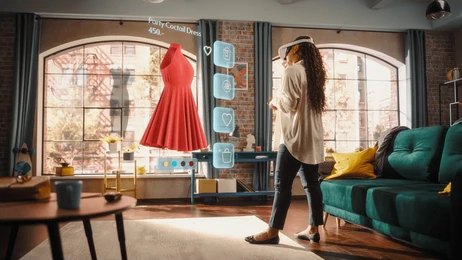Let me tell you about the last time AI-Generated clothes saved my online shopping disaster. I’d ordered a dress labeled “one-size-fits-all” (spoiler: it didn’t). But today, thanks to AI clothes, I can skip the guessing game. Now imagine this: an app that lets you try on clothes digitally, tailored to your exact measurements. No guesswork. No returns. Just… magic. Welcome to the world of AI clothes—where fashion isn’t just worn anymore. It’s engineered.
From Mood Boards to Machine Learning: How AI Clothes Are Born
Gone are the days when designers sketched solely by hand. Last month, I watched a friend type “retro-futuristic jumpsuit” into an AI tool. Seconds later, her screen lit up with designs that mashed 70s disco with cyberpunk edge. Tools like DALL-E aren’t just assistants—they’re collaborators. By crunching data from decades of trends and cultural shifts, AI clothes emerge as wild hybrids humans might never dream up.
And here’s the twist: designers aren’t obsolete. They’re empowered. Take Auroboros, a brand crafting digital-only AI clothes for avatars. Their “bioluminescent trench coat” sold as an NFT? Pure genius—and proof that fashion now lives beyond fabric.
The Fitting Room That Fits in Your Phone
Raise your hand if you’ve returned clothes because “small” felt like “extra-small.” AI clothes fix this chaos. Apps like Zalando’s AR Mirror map your body in 3D, letting you “try” a sequined gown or tailored blazer in your living room. I tested it last week—the dress hugged my curves like it was sewn for me. No shipping. No regrets. Just pure confidence.
For brands, this isn’t just cool tech—it’s survival. Returns cost billions and fuel climate guilt. With AI clothes, fewer mistakes mean less waste. Sustainability just got stylish.
Meet the Brands Where Robots Run the Show
Ever heard of The Fabricant? They’re a fashion house that’s never touched a sewing machine. Their entire collection? AI clothes—digital garments that shift color, texture, or even shape based on your mood. Want a jacket that glows when you’re happy? They’ll code it. For Gen Z, raised on selfies and self-expression, digital clothes aren’t weird—they’re necessary.
Why This Matters: More Than Just Pretty Pixels
Let’s cut through the hype. AI clothes aren’t just flashy tech—they’re fixing fashion’s flaws:
- Sustainability: AI predicts trends so brands produce only what sells. Less landfill, more planet.
- Inclusivity: Algorithms ignore size charts. AI clothes adapt to your body, not the other way around.
- Speed: Fast fashion’s 6-month cycle? Try 6 days.
But let’s get real. When I asked a Milanese tailor about AI-generated fashion, he shrugged: “Can a machine feel the drape of chiffon? The pride in a hand-stitched hem?” Touché. AI might mimic artistry, but can it care?
The Big Question: Who Owns an AI Dress?
Who gets credit when a robot designs a gown? The programmer? The user who typed “sparkly unicorn vibe”? Courts are battling this now. And let’s not ignore the human cost: factories replaced by code, artisans sidelined for speed. AI clothes should uplift humans, not erase them.
Your Future Wardrobe: Self-Healing, Shape-Shifting, Smart
Picture this: a winter coat that thickens when snow falls. A dress that repairs its own snags. Startups like Pangaia are already weaving AI into fabrics. AI-Generated clothes aren’t tomorrow—they’re today.
Final Stitch: Why I’m Not Scared of Robot Designers
AI clothes aren’t here to replace us. They’re here to reimagine what fashion can be. The sewing machine didn’t kill craftsmanship—it set it free. AI is doing the same, one algorithm at a time.
So next time you battle a zipper or curse a size chart, remember: the future of fashion isn’t in a Parisian atelier. It’s in lines of code. And honestly? I’m ready to hit refresh.


Leave a Reply